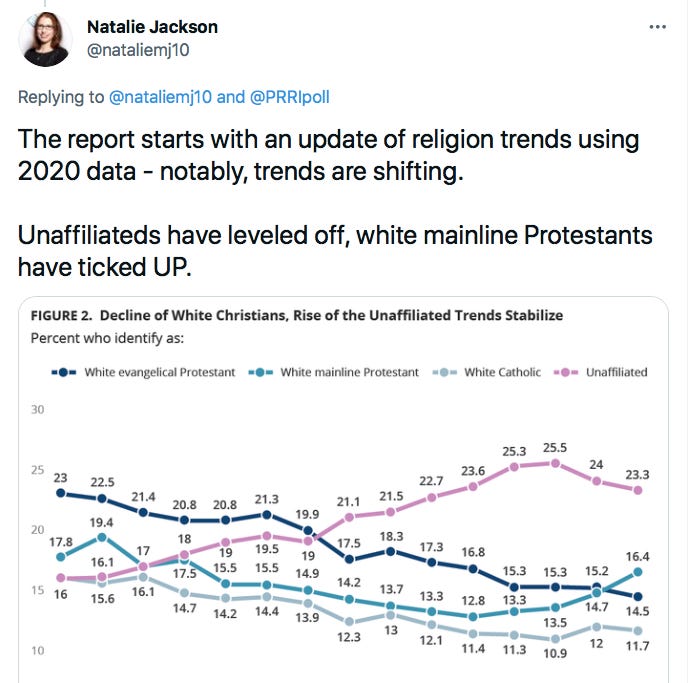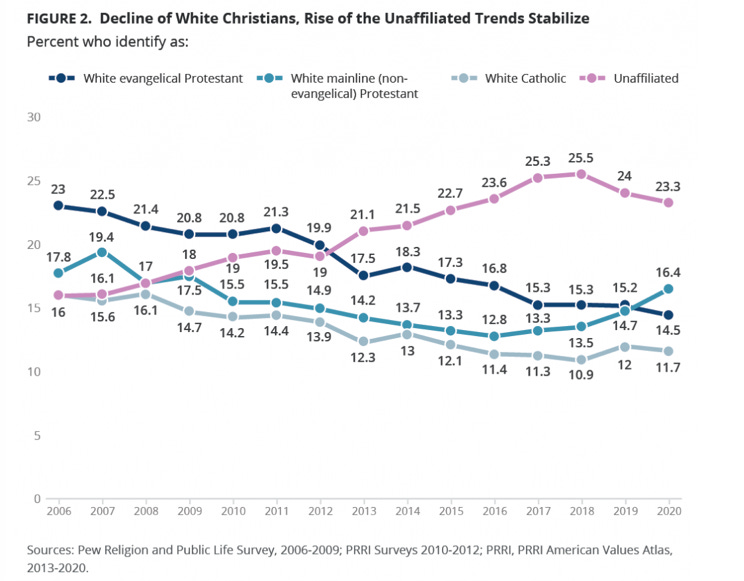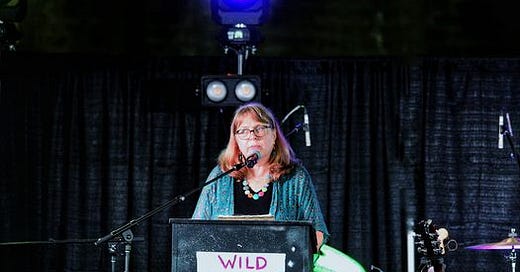

Discover more from The Cottage
Not Dead Yet
White mainline Protestants now outnumber white evangelicals, and conventional wisdom goes out the window.
In the early 1990s, I was a member of Trinity Episcopal Church in Santa Barbara, California. At the time, few people attended services in the nearly 700 seat neo-Gothic sanctuary. On a particular Sunday, an usher counted the people at worship. Fewer than 60. “It can’t get much worse,” she thought as she dusted cobwebs from the back pews. “Pretty soon, we’ll be closed.”
Trinity didn’t close. Through a remarkable set of circumstances, committed leaders, and hard work, the church came to life once again. In the four years in which I attended, Trinity grew from that 60 to over three hundred, and kept growing for the next several years. It is still a vibrant, vital congregation.
How did this happen? Trinity broke all the conventional wisdom of church growth. They preached politics from the pulpit. They married gay members before marriage equality was legal in California. They went to protest marches. They innovated liturgy. They read liberal theology books, studied feminist and liberation theology, embraced contemporary biblical criticism. They followed no plan - except for believing that Christianity was an adventure and that Christian community could be transformative, challenging, and deeply spiritual in and for the world.
In those days, most historians and sociologists of religion taught something called “The Kelley Thesis.” In 1972, Dean M. Kelley wrote a book entitled Why Conservative Churches Are Growing that suggested that conservative churches with strict boundaries and sect-like tendencies would always grow while liberal churches that had accommodated to culture would always decline. For the two decades following his book, as mainline numbers sank and evangelical churches flourished, Kelley seemed right. In the minds of most observers of American religion, Why Conservative Churches Are Growing had become a statement of fact: Only conservative churches can grow. When people repeat this mantra, they probably don’t know where it originated. It has become a cultural commonplace.
Trinity declined. It almost closed. But then, it didn’t. In 1994, I wrote about it in the local newspaper. And, since then, I’ve written about how wrong-headed the Kelley thesis is - suggesting that there would come a time when evangelical churches would go into a demographic tailspin. I optimistically hoped that the pendulum of conservative and liberal Protestantism might swing (at least a little) in the direction of mainline churches again. Because it really isn’t about conservative and liberal. Christianity in (or, perhaps, the “Christianities” of?) America involves a host of complex concerns about generational shifts, political issues, cultural tastes, and, most of all, the ever-present spiritual wandering of a people shaped by religious experience and a nomadic soul.
But, even two decades after Trinity in which time I’ve written countless columns, eleven books, and delivered thousands of lectures and sermons on these subjects, I was surprised by a tweet this morning from Natalie Jackson of Public Religion Research Institute (full disclosure - I was on the PRRI board for ten years):

Here’s the full version of the same chart (with dates - they weren’t visible on the tweet):
Look closely. In 2016, white mainline Protestants sank to their all-time low as a percentage of the American population: 12.8% In the four years following, the number starts ticking up - reaching 16.4% now, the highest percentage since 2009.
At the same time, the percentage of people who identify as white evangelicals has been sinking - in an astonishing fall from 23% at the 2006 baseline in this data set to 14.5% now.
I don’t have the exact numbers at hand, but I am fairly certain that there hasn’t been a time since 1980 when the percentage of white mainline Protestants in the general population was HIGHER than the percentage of white evangelicals. That’s at least four decades - maybe longer. But this is a genuine shift away from white evangelicalism toward mainline Protestantism.
On July 8, 2021, shortly before its 50th birthday, the Kelley thesis died.
Good riddance, I say.
* * * * *
Now what?
It is reasonable to assume that a certain percentage of former white evangelicals are making their way toward white mainline churches - and it is important to be clear about what is going on regarding this shift.
First, people are leaving white evangelicalism for a host of political, social, and theological reasons. Some of the best research suggests that people are leaving conservative churches because they don’t believe what those communities teach any longer. “Believe” is a fluid word here - leavers may still believe (for example) in the Trinity or the Virgin Birth but they don’t believe that Trump was ordained by God to be president or that LGBTQ people are lesser or that women should submit to their husbands. Or they may not believe the Bible is true and may be struggling with fairly conventional views of race.
For some reason of “belief,” however, they increasingly felt outside of white evangelical communities, their relationships strained, and they made a difficult decision to walk away. Many of those leaving white evangelicalism are steeped in conservative theologies and know the Bible well. They are often sad, angry, and wounded, and perhaps tentative about participating in new churches. They are used to particular styles of worship, lay involvement, and church offerings (simple things like decent parking lots and babysitting for kids) and may find even the most welcoming and inclusive mainline church lacking in such things.
Second, trends aren’t destiny. Just because this is happening now doesn’t mean it is going to happen forever - or even for the next decade. It could be that the mainline is a way station for people who will eventually leave Christianity altogether. But there’s no knowing that. People in mainline churches should understand that four years of growth does not validate everything that the denomination does or every custom or practice in a particular congregation.
This is a moment to listen well to those who may be coming your way. For heaven’s sake, don’t ever tell a newcomer “we don’t do it that way” or “don’t sit here! that’s my pew!” This shift is occurring, in large part, because white evangelical churches have failed, not necessarily because mainline churches are doing everything right. Hubris is not the right response to the data, but self-reflection is.
Third, share your story with wisdom, grace, humility, and hospitality. When a major religious shift is underway, there’s nothing more important then to tell your story. The people who are brave enough to walk in your doors or spend time reading your website can’t read your mind and don’t remember the former pastor or the beloved member who died twenty years ago. They don’t want to know when the building was renovated or who donated the windows. Your story isn’t a timeline - it is about the spirit of community, what motivates you, where you find meaning, your hopes and fears and gifts.
Mainline churchgoers generally assume simple things like infant baptism, the flow of the Christian year, and written liturgy and lectionaries. They know multiple verses of old-fashioned hymns, like classical music, and can tell the difference between a Calvinist and a Wesleyan. Mainliners also regard private religious experience pretty highly, don’t wear their faith on their sleeves, know lots of stuff about capital campaigns, bad sound systems, and broken air-conditioners, and really like helping people. Oh. And funerals. Mainline churches do those well. In short, mainliners live inside a particular history, are shaped by poetic words, remember the value of quiet faith and thoughtful reflection, show God through the works of one’s hands more than in words, and understand failure and death. In other words, the practice of mainline Christianity is (not always, but in large part) different than the assumed practices of most of American evangelicalism. Mainline types need to be prepared to explain that - all of it - to newcomers. Assume nothing. And be prepared to laugh - and learn a few things about yourself in the process of knowing and telling your story.
* * * * *
Over the next weeks and months, there will be much more to write, many arguments to be had, and challenges to be faced in regard to this shift. There will be a conversation about labels and what counts as “mainline” and whether or not the emergent church movement had an impact on all this. There will be important theological and social engagement with how race and racism has played in the shift and how it will play out in the future. I suggested a couple more things in this Twitter thread about leadership and change. Despite all the unanswered questions, the implications of the shift couldn’t be more important for politics, social issues, and culture - as well as the future of Christianity in America in a post-Christian age.
But, right now, it is enough to know you are living in history. A really important moment is here. The story of an old religious tradition hasn’t ended the way critics once thought. Paraphrasing the words of the old Monty Python sketch, “we’re not dead yet.” We’ve just been awaiting resurrection.
INSPIRATION
You must give birth to your images.
They are the future waiting to be born.
Fear not the strangeness you feel.
The future must enter you
long before it happens.
Just wait for the birth,
For the hour of new clarity.
– Rainer Maria Rilke
I believe we can change the world if we start listening to one another again. Simple, honest, human conversation. Not mediation, negotiation, problem-solving, debate, or public meetings. Simple, truthful conversation where we each have a chance to speak, we each feel heard, and we each listen well.
– Margaret J. Wheatley
Religion, whether we like it or not, is intimately tied to the culture in which it exists. One can argue—with only varying degrees of success, though—that private faith can exist independent of its cultural surround. When, however, two or three faith-filled believers come together, a religion—possibly more of a nascent or proto-religion—is formed. Once formed, it can never be separated entirely from its context. Just as surely as one of the functions of religion is to inform, counsel, and temper the society in which it exists, just so surely is every religion informed and colored by its hosting society. Even a religion’s very articulation of itself takes on the cadences, metaphors, and delivery systems of the culture that it is in the business of informing. Thus, when we look at these semi-millennial tsunamis of ours, we as Christians must be mindful of the fact that the religious changes effected during each of them were only one part of what was being effected, and that all the other contemporaneous political, social, intellectual, and economic changes were intimately entwined with the changes in religion and religious thought.
― Phyllis Tickle
If we think of belonging only as membership in a club, organization, or church, we miss the point. Belonging is the risk to move beyond the world we know, to venture out on pilgrimage, to accept exile. And it is the risk of being with companions on that journey, God, a spouse, friends, children, mentors, teachers, people who came from the same place we did, people who came from entirely different places, saints and sinners of all sorts, those known to us and those unknown, our secret longings, questions, and fears.
― Diana Butler Bass, Christianity After Religion
Spiritual awakening is not ultimately the work of invisible cultural forces. Instead, it is the work of learning to see differently, of prayer, and of conversion. It is something people do.
― Diana Butler Bass, Christianity After Religion
The whole message of the Christian scripture is based in the idea of metanoia, the change of heart that happens when we meet God face-to-face. Even a cursory knowledge of history reveals that Christianity is a religion about change. The Christian faith always changes - even when some of its adherents claim that it does not.
― Diana Butler Bass, Christianity for the Rest of Us
WHAT AMAZING TIMING!
Weeks BEFORE today’s survey release, FaithLead invited me to offer a Summer Refresher on AFTER Christianity After Religion - to talk about trends over the last ten years, to reflect about the themes of my writing, and explore what I’m thinking now about the future of Christianity in North America. Now, we’ll be talking about this specific study, this shift, and what these changes mean for leadership, spirituality, cultural issues (especially race and politics) and potential points of challenge within denominations.
This will be a live and interactive event on July 23 and 24. There are still seats available - and if you can’t attend live, it will be recorded for later viewing.
CLICK HERE for more info and registration. Readers of The Cottage receive a discount. ENTER CODE: COTTAGE0725.
ALSO: Those who register by JULY 9 will be entered in a drawing for one of five autographed copies of Christianity After Religion.












The same PRRI report also shows age group pictures: mainline churches showed higher percentages than evangelicals among 18-29 and 30-49 who have been rapidly de-churched. This could be interpreted that young members of mainline churches are less likely to leave (though many still do) compared to their evangelical counterparts.
Thank you for this information